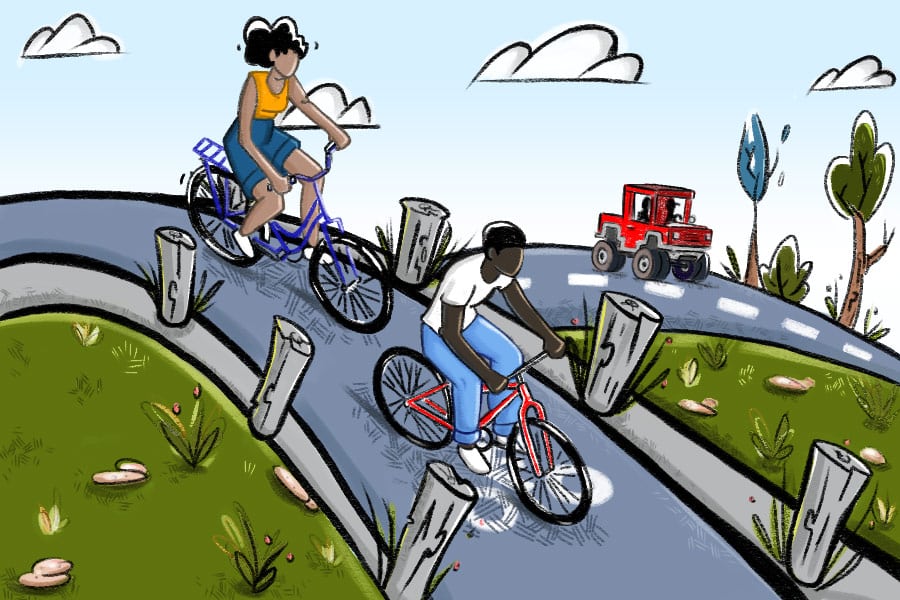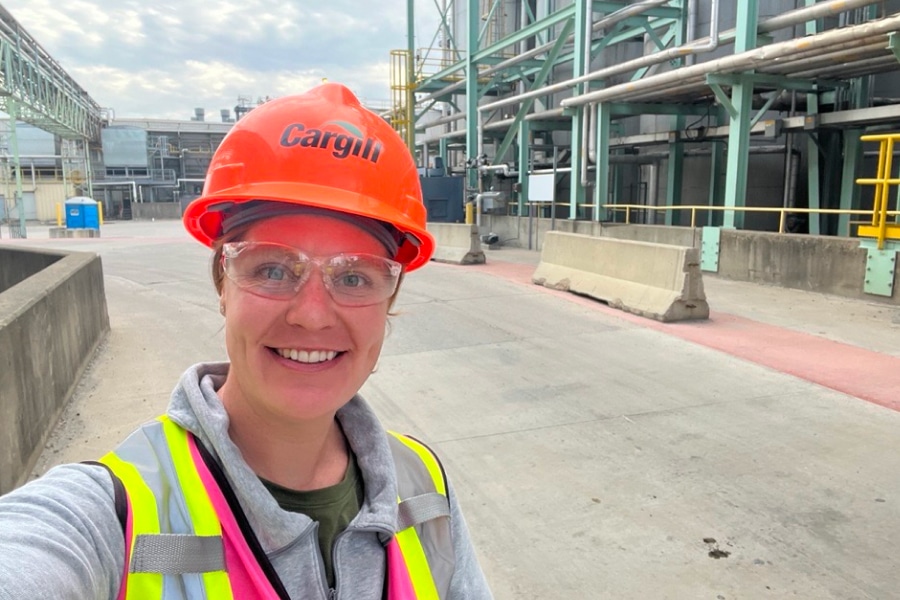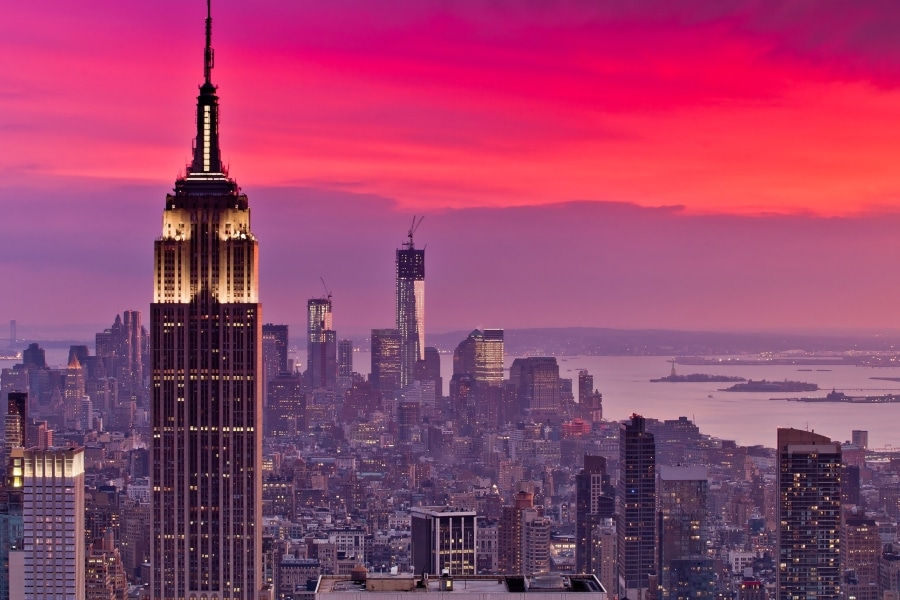Illustration by Sam Barks
Urban motorists have warily co-existed with bicyclists on American streets for decades. These cyclists have included fearless bike messengers as well as fitness- or climate-conscious riders spinning for recreation or commuting to work.
Taking cues from European cities, which have historically been more accommodative to cyclists, U.S. cities had been making slow but significant progress in promoting bike-friendly modes of transportation, laying out thousands of miles of dedicated bike infrastructure.
Then 2020 came and provided an unexpected boost to cyclists’ cause: The COVID-19 pandemic.
As the economy went into lockdown, normally gridlocked streets emptied. Commuters and shoppers who normally traveled on crowded buses and subways seemingly vanished. People who never would have felt comfortable duking it out with urban drivers ventured out on bikes for the first time. Stores sold out of bicycles faster than they could stock them.
Governments and corporate executives have recently worked to re-open the economy, anticipating a downturn in COVID-19 infections. But that downturn has yet to happen, leaving many offices still empty. In many cities, streets have been closed to traffic to provide space not only for pedestrians and cyclists but for outdoor dining.
As the crisis drags on into the latter quarter of 2020, cities are under pressure to consider new ways to use streets. This has propelled renewed interest in bicycle infrastructure, as advocates push planners to use the current lull in car traffic to alter roadways to support increased bike use for after the pandemic recedes.
“The challenge is that we are seeing an increased demand for bike infrastructure, just as city sales tax revenues are falling off a cliff,” said Joe Gilpin, vice president at Alta Planning + Design and an expert in bicycle facility design. “The unmet need seems to be greater and more visible in the community, when cities are having a hard time funding even their emergency services and keeping basic programs going.”
The 2-5 mile sweet spot
In a lot of communities, biking and walking are seen as recreational amenities—not intrinsic parts of the transportation system. “But there’s a sweet spot for bicycle trips, between 2-5 miles,” Gilpin said. “If the city is laid out well, it’s going to have destinations—commercial centers, schools and so on—within that distance from anywhere. It doesn’t matter how big the city is. If destinations are easy to get to, people will use their bikes.”
Conversely, in a city with a homogeneous fabric, where destinations are far away for a lot of the people, biking is unlikely to represent an important mode of transportation. Still, Gilpin maintained that any city can benefit from investment.
“In places with extremely long blocks, primarily serving as multilane, arterial roadways between disconnected residential street grids, it’s hard to create connectivity across the city,” Gilpin said. “But you can create utility corridors, or local street bikeways. You can connect cul-de-sacs to create bicycle and pedestrian connectivity that doesn’t involve cars so riders can avoid those arterials that feel unsafe.”
A manual for design thinking
Contemporary biking design concepts in the U.S. are rooted in the administration of former New York City Mayor Michael Bloomberg and his visionary transportation director, Janette Sadik-Khan, who oversaw development of 400 miles of bike lanes between 2007 and 2013. Cities all across the U.S. have followed suit.
Gilpin was a contributor to the NACTO Urban Bikeway Design Guide, first published in 2011 and widely considered the touchstone for designers of bicycle infrastructure. “Over the last decade, our understanding of the needs of different types of users has evolved,” Gilpin said. “A very small subset of Americans identify personally as committed bicyclists. If you design infrastructure that caters specifically to that small segment, only a small number of people use it.”
The best ideas about bike infrastructure have come from northern Europe—flat places like the Netherlands and Denmark, where the habit of cycling is deeply ingrained in society. In the U.S., the design concepts most widely in use address only a tiny segment of the population.
“Many Americans aren’t comfortable riding a bike on an arterial road, sharing a lane with faster moving traffic,” Gilpin said. “With a conventional bike lane, you’re still only addressing 6-8% of the population. But once you provide infrastructure that physically separates the rider from perceived danger of motor vehicle traffic, the inclusivity bubble starts to get bigger.”
Before the NACTO guide was published, there were few protected bike lanes in the U.S., according to Conor Semler, associate planner at Kittleson & Associates and another contributor to the guide. “The NACTO guide was the first publication in the U.S. context for separated bike design,” Semler said.
American cyclists vs. drivers
Until recently, designers trying to facilitate better co-existence between cars and bikes were most concerned with keeping car traffic flowing. Frequently the emphasis has been on minimizing the delay for cars, Gilpin said.
“The main problem is turning vehicles,” Gilpin said. “That’s where your conflicts are going to be the riskiest. The ideal is to separate bikes from other vehicles in time and space. It might be a dedicated signal allowing just pedestrians and bicyclists to go through, but that has consequences in terms of delaying vehicles. You can grid-separate or have an alternate route. There’s no one solution that fits all locations.”
You can impose strict rules on people driving in cars, but with bicycles, you have to account for human nature.
“We do an awful job in this country of teaching people how to behave in traffic,” Gilpin said. “You take a driver’s test when you’re 15 and never get tested again. In other countries, there are ‘traffic gardens’ where they train kids, and they have a curriculum that begins with the very basics when they’re really young, even before they’re old enough to judge speed and distance. We don’t spend any time teaching kids how to be good users of the traffic infrastructure.”
There is a segment of the population who already are comfortable riding their bikes on the streets. Those enthusiasts often have opposed dedicated bike infrastructure. “They don’t want to be forced to ride in separated lanes, stuck behind someone who’s riding slowly,” Semler said.
‘Many Americans aren’t comfortable riding a bike on an arterial road, sharing a lane with faster moving traffic. With a conventional bike lane, you’re still only addressing 6-8% of the population. But once you provide infrastructure that physically separates the rider from perceived danger of motor vehicle traffic, the inclusivity bubble starts to get bigger.’
Joe Gilpin, vice president at Alta Planning + Design and an expert in bicycle facility design
Infrastructure designers have now embraced the concept of cycling as a purposeful mode of transportation in cities. Still, Semler said: “The prevailing sentiment among designers is that people should have a choice whether to ride in a dedicated bike lane or in the travel lane with traffic.”
An array of design options
Designers have catalogued a range of solutions to the problem of making cyclists comfortable navigating city streets, spawning a whole new vocabulary of bike lane typologies. Only a small segment of the population feels comfortable riding in a bike lane shared with traffic. But 50-60% of the population would feel comfortable bicycling if they had dedicated infrastructure, Semler said.
A “cycle track”—sometimes called a separated bike lane or protected bike lane—is a lane reserved exclusively for the use of bicyclists, immediately adjacent to or within a roadway, with some type of vertical separation between cars and the bike lane. The barrier may consist of flexible posts, a curb, or planter boxes.
That physical separation is what distinguishes a cycle track from a “buffered bike lane,” in which the separation is visual—paint on the street, usually green. A conventional bike lane has one white stripe between the cars and the bike lane.
“The cycle track is the most preferred treatment for people riding bikes,” Semler said. “But it also tends to take up the most space on the street that would otherwise be devoted to parking or driving, or to sidewalks. To remove parking spaces for a bike lane is usually controversial. People are very defensive of parking. Most people still see bike lanes as an investment for others, and not for them.”
Americans are taught to ride bicycles with the flow of car traffic. Counterintuitively, bike lanes may be designed for two-way or counter-flow bike traffic, particularly on one-way streets.
“Often, bicyclists will not go two blocks out of their way to find a street with the right directional flow,” Gilpin said. “They will just go against the flow on a one-way street—we call it ‘salmoning.’ If you put in a single direction bike lane on that one-way street, you will have bikes going in both directions. We know from the crash data that that is inherently dangerous. Usually, these are short connections, rather than miles-long treatments. It’s a way to make a specific connection and improve the safety.”
It remains to be seen whether the renewed interest in bike infrastructure will stick once the pandemic passes and motorists return to the streets. Clearly, the environmental argument for bicycle commuting will not have gone away.












